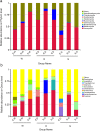Succession of endophytic fungi and arbuscular mycorrhizal fungi associated with the growth of plant and their correlation with secondary metabolites in the roots of plants
- PMID: 33820543
- PMCID: PMC8022407
- DOI: 10.1186/s12870-021-02942-6
Succession of endophytic fungi and arbuscular mycorrhizal fungi associated with the growth of plant and their correlation with secondary metabolites in the roots of plants
Abstract
Background: To decipher the root and microbial interaction, secondary metabolite accumulation in roots and the microbial community's succession model during the plant's growth period demands an in-depth investigation. However, till now, no comprehensive study is available on the succession of endophytic fungi and arbuscular mycorrhizal fungi (AMF) with roots of medicinal licorice plants and the effects of endophytic fungi and AMF on the secondary metabolite accumulation in licorice plant's root.
Results: In the current study, interaction between root and microbes in 1-3 years old medicinal licorice plant's root and rhizospheric soil was investigated. Secondary metabolites content in licorice root was determined using high-performance liquid chromatography (HPLC). The composition and diversity of endophytic and AMF in the root and soil were deciphered using high-throughput sequencing technology. During the plant's growth period, as compared to AMF, time and species significantly affected the diversity and richness of endophytic fungi, such as Ascomycota, Basidiomycota, Fusarium, Cladosporium, Sarocladium. The growth period also influenced the AMF diversity, evident by the significant increase in the relative abundance of Glomus and the significant decrease in the relative abundance of Diversispora. It indicated a different succession pattern between the endophytic fungal and AMF communities. Meanwhile, distance-based redundancy analysis and Mantel tests revealed root's water content and secondary metabolites (glycyrrhizic acid, liquiritin, and total flavonoids), which conferred endophytic fungi and AMF diversity. Additionally, plant growth significantly altered soil's physicochemical properties, which influenced the distribution of endophytic fungal and AMF communities.
Conclusions: This study indicated a different succession pattern between the endophytic fungal and AMF communities. During the plant's growth period, the contents of three secondary metabolites in roots increased per year, which contributed to the overall differences in composition and distribution of endophytic fungal and AMF communities. The endophytic fungal communities were more sensitive to secondary metabolites than AMF communities. The current study provides novel insights into the interaction between rhizospheric microbes and root exudates.
Keywords: Arbuscular mycorrhizal fungi; Endophytic fungi; High-throughput sequencing; Medicinal licorice; Plant growth; Secondary metabolites.
Conflict of interest statement
The authors declare that they have no competing interests.
Figures








Similar articles
-
Root-associated endophytic bacterial community composition and structure of three medicinal licorices and their changes with the growing year.BMC Microbiol. 2020 Sep 21;20(1):291. doi: 10.1186/s12866-020-01977-3. BMC Microbiol. 2020. PMID: 32957914 Free PMC article.
-
Differences in the endophytic fungal community and effective ingredients in root of three Glycyrrhiza species in Xinjiang, China.PeerJ. 2021 Mar 9;9:e11047. doi: 10.7717/peerj.11047. eCollection 2021. PeerJ. 2021. PMID: 33854843 Free PMC article.
-
Tripartite Interactions Between Endophytic Fungi, Arbuscular Mycorrhizal Fungi, and Leymus chinensis.Microb Ecol. 2020 Jan;79(1):98-109. doi: 10.1007/s00248-019-01394-8. Epub 2019 Jun 8. Microb Ecol. 2020. PMID: 31177395
-
Possible role of arbuscular mycorrhizal fungi and associated bacteria in the recruitment of endophytic bacterial communities by plant roots.Mycorrhiza. 2021 Oct;31(5):527-544. doi: 10.1007/s00572-021-01040-7. Epub 2021 Jul 20. Mycorrhiza. 2021. PMID: 34286366 Free PMC article. Review.
-
Arbuscular mycorrhizal fungi and production of secondary metabolites in medicinal plants.Mycorrhiza. 2022 Jul;32(3-4):221-256. doi: 10.1007/s00572-022-01079-0. Epub 2022 May 13. Mycorrhiza. 2022. PMID: 35556179 Free PMC article. Review.
Cited by
-
Community ecological succession of endophytic fungi associates with medicinal compound accumulation in Sophora alopecuroides.Microbiol Spectr. 2024 Feb 6;12(2):e0307623. doi: 10.1128/spectrum.03076-23. Epub 2024 Jan 18. Microbiol Spectr. 2024. PMID: 38236025 Free PMC article.
-
Succession of endophytic fungi and rhizosphere soil fungi and their correlation with secondary metabolites in Fagopyrum dibotrys.Front Microbiol. 2023 Aug 1;14:1220431. doi: 10.3389/fmicb.2023.1220431. eCollection 2023. Front Microbiol. 2023. PMID: 37601353 Free PMC article.
-
Diversity and Correlation Analysis of Endophytes and Top Metabolites in Phlomoides rotata Roots from High-Altitude Habitats.Microorganisms. 2025 Feb 25;13(3):503. doi: 10.3390/microorganisms13030503. Microorganisms. 2025. PMID: 40142396 Free PMC article.
-
Study on Betaine and Growth Characteristics of Lycium chinense Mill. in Different Cultivation Environments in South Korea.Plants (Basel). 2024 Aug 20;13(16):2316. doi: 10.3390/plants13162316. Plants (Basel). 2024. PMID: 39204752 Free PMC article.
-
Assessment of nutritional value, aerobic stability and measurement of in vitro fermentation parameters of silage prepared from several leguminous plants.BMC Plant Biol. 2025 May 15;25(1):641. doi: 10.1186/s12870-025-06663-y. BMC Plant Biol. 2025. PMID: 40375158 Free PMC article.
References
-
- Xie W, Hao Z, Yu M, Wu Z, Zhao A, Li J, Zhang X, Chen B. Improved phosphorus nutrition by arbuscular mycorrhizal symbiosis as a key factor facilitating glycyrrhizin and liquiritin accumulation in Glycyrrhiza uralensis. Plant Soil. 2019;439(1-2):243–257. doi: 10.1007/s11104-018-3861-9. - DOI
-
- Tianshui Niu JY, Zhang L, Cheng X, Li K, Zhou G. Research advances on anticancer effect of licorice. Curr Bioact Comp. 2009;5:1–9. doi: 10.2174/157340709787580883. - DOI
-
- Li-Ping L, Cui-Ai R, Hong-Yan Z. Research Progress on Immunomodulatory Effects of Glycyrrhizin. chinese journal of experimental traditional medical formulae. 2010; 272–276.
MeSH terms
LinkOut - more resources
Full Text Sources
Other Literature Sources
Medical

